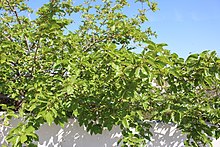নুনী
নুনী (ইংৰাজী: white mulberry, silkworm mulberry, বৈজ্ঞানিক নাম: Morus alba)[2] সৰুৰ পৰা মজলীয়া আকাৰৰ এবিধ moraceae পৰিয়ালৰ উদ্ভিদ। ই প্ৰায় ১০–২০ মিটাৰ (৩৩–৬৬ ফুট) ওখ হ'ব পাৰে। তুলনামূলকভাৱে নুনী গছৰ আয়ুসকাল কম যদিও কোনো কোনো ক্ষেত্ৰত ই ২৫০ বছৰ পৰ্যন্ত জীয়াই থকাৰ উদাহৰণ পোৱা যায়।[3] এই প্ৰজাতিটো ভাৰত[4] আৰু মধ্য চীনৰ থলুৱা উদ্ভিদ।[5] বাকী স্থান, যেনেঃ আমেৰিকা যুক্তৰাষ্ট্ৰ, মেক্সিকো, অষ্ট্ৰেলিয়া, কিৰ্গিজস্তান, আৰ্জেণ্টিনা, তুৰ্কী, ইৰাণ আদি দেশতো ইয়াৰ খেতি প্ৰচুৰ পৰিমাণে কৰাৰ লগতে প্ৰাকৃতিককৰণ কৰি তোলা হৈছে।[6] [7][8][9][10][11]
| নুনী White mulberry | |
|---|---|

| |
| বৈজ্ঞানিক শ্ৰেণীবিভাজন | |
| Unrecognized taxon (ঠিক কৰক): | Morus |
| প্ৰজাতি: | M. alba |
| দ্বৈৰাশিক নামকৰণ | |
| Morus alba L. 1753 | |
| Subspecies | |
| |
| সমাৰ্থক[1] | |
| |
নুনী গছৰ খেতি ৰেচম সূতাৰ বাণিজ্যিক উৎপাদনৰ বাবে পলুক খুৱাবলৈ বুলি কৰা হয়। নুনীফুলৰ ৰেণুৰ তড়িৎ গতিৰ বিস্তাৰৰ বাবেও (শব্দৰ গতিবেগৰ আধাতকৈয়ো বেছি) ই বিশেষভাৱে পৰিচিত।[12] নুনীগছৰ পকা ফল খাদ্য হিচাপে গ্ৰহণ কৰা হয়।
বিৱৰণ
সম্পাদনা কৰককম বয়সীয়া ডালত পাতবোৰ ৩০ চে.মি. (১২ ইঞ্চি) পৰ্যন্ত দীঘল আৰু জটিল খাঁজযুক্ত হ'ব পাৰে। পুৰণি গছৰ পাতবোৰ সাধাৰণতে ৫–১৫ চে.মি. (২-৫.৯ ইঞ্চি) পৰ্যন্ত হ'ব পাৰে। সাধাৰণতে নাতিশীতোষ্ণ অঞ্চলত গছবোৰ পৰ্ণপাতী হয় যদিও গ্ৰীষ্মমণ্ডলীয় অঞ্চলত গজা গছবোৰ চিৰসেউজ হ’ব পাৰে।
ফুলবোৰ একক লিংগৰ কেশৰবিশিষ্ট। পুংকেশৰ ২–৩.৫ চে.মি. (০.৮–১.৪ ইঞ্চি) আৰু গৰ্ভকেশৰ ১–২ চে.মি. (০.৪–০.৮ ইঞ্চি) দীঘল। মতা আৰু মাইকী ফুল সাধাৰণতে পৃথক পৃথক গছত পোৱা যায় যদিও ই একেজোপা গছতো থাকিব পাৰে।[13][14] একোটা ফল ১–১.৫ চে.মি.(০.৪–০.৬ ইঞ্চি) দীঘল হয়। বনৰীয়া গছৰ ফল গাঢ় বেঙুনীয়া ৰঙৰ হয় যদিও বহুতো কৃষিজাত ফল বগাৰ পৰা গোলাপী ৰঙলৈকে ভিন্ন হয়। ৰঙা নুনী আৰু ক'লা নুনীৰ অধিক গাঢ় সোৱাদৰ বিপৰীতে ই মিঠা কিন্তু মৃদু। ফলভক্ষী চৰাইৰ মলৰ দ্বাৰা বীজবোৰ বহুলভাৱে বিস্তাৰিত হৈ পৰে।[6][7][15]
কৃষিকাৰ্য
সম্পাদনা কৰকৰেচমৰ পলুৱে খাবৰ বাবে নুনীগছৰ খেতি ৪৭০০ বছৰতকৈও অধিক কালৰ আগতে চীনত আৰম্ভ হৈছিল আৰু তাৰ পিছৰ পৰা আন দেশতো ইয়াক প্ৰৱৰ্তন কৰা হৈছে। প্ৰাচীন গ্ৰীক আৰু ৰোমানসকলে ৰেচমৰ পলুৰ বাবে নুনীৰ খেতি কৰিছিল। কমেও ২২০ খ্ৰীষ্টাব্দৰ পৰাই সম্ৰাট এলাগাবালাছে ৰেচমৰ চোলা পিন্ধিছিল।[16] দ্বাদশ শতিকাত ইউৰোপৰ অন্যান্য অংশত আৰু পঞ্চদশ শতিকাত স্পেইনৰ বিজয়ৰ পিছত লেটিন আমেৰিকালৈ ইয়াক বহন কৰি নিয়া হয়।[17] ২০০২ চনত চীনত ৬,২৬০ কিলোমিটাৰ বৰ্গফুট ভূমি এই প্ৰজাতিটোৰ খেতিৰ বাবে নিয়োজিত কৰা হৈছিল।[7]
ভাৰতীয় উপমহাদেশৰ পৰা[7] পশ্চিমে আফগানিস্তান আৰু ইৰাণৰ মাজেৰে দক্ষিণ ইউৰোপলৈকে ৰেচমৰ পলুক খাদ্য যোগান ধৰিবলৈ পাতৰ বাবে ইয়াক হাজাৰ বছৰতকৈও অধিক সময় ধৰি বহুলভাৱে খেতি কৰা হৈছে।[15]
শেহতীয়াকৈ ই উত্তৰ আমেৰিকাৰ বহু অংশৰ চহৰ অঞ্চলৰ লগতে পথৰ কাষ আৰু অৰণ্য প্ৰান্তৰ দৰে বিক্ষিপ্ত অঞ্চলত ব্যাপকভাৱে প্ৰাকৃতিক হৈ পৰিছে, য'ত ই স্থানীয়ভাৱে স্থানীয় ৰঙা নুনীৰ (Morus rubra) সৈতে সহজেই বৰ্ণ-সংকৰিত হয়। কিছুমান অঞ্চলত এনে ব্যাপক সংকৰকৰণৰ বাবে ৰঙা নুনীৰ দীৰ্ঘম্যাদী জিনীয় স্থিতিশীলতাৰ বাবে এতিয়া গুৰুতৰ চিন্তাৰ সৃষ্টি হৈছে।[18]
এই প্ৰজাতিটো এতিয়া বিশ্বৰ সমগ্ৰ উষ্ণ নাতিশীতোষ্ণ আৰু উপবাৰ্কটিক অঞ্চলতো ব্যাপকভাৱে ৰোপণ আৰু ব্যাপকভাৱে প্ৰাকৃতিককৰণ কৰা হৈছে। ই ৪,০০০ মিটাৰ (১৩,০০০ ফুট) পৰ্যন্ত উচ্চতাত জীয়াই থাকিব পাৰে। নুনী গছ মৃদু এচিডিক, ভালদৰে পানী নিষ্কাশন কৰা, বালিচহীয়া মাটিত ভাল হয় যদিও ইহঁতে অন্য মাটিতো জীৱন ধাৰণ কৰিব পাৰে।[17]
ব্যৱহাৰ
সম্পাদনা কৰকনুনীৰ পাত ৰেচম পলুৰ বাবে পছন্দৰ খাদ্য। খৰাঙৰ ফলত গছ-গছনিৰ উপলব্ধতা বাধাগ্ৰস্ত হোৱা অঞ্চলত পশুধনৰ (গৰু, ছাগলী আদি) খাদ্যৰ বাবেও ইয়াক ব্যৱহাৰ কৰিব পাৰি। কোৰিয়াত নুনীৰ পাতৰ পৰা চাহ প্ৰস্তুত কৰা হয়। ফলসমূহো শুকুৱাই বা মদ তৈয়াৰ কৰি খোৱা হয়।[7][15]
চিত্ৰ বিথীকা
সম্পাদনা কৰক-
বসন্ত কালত মতা ফুল আৰু পাত
-
পত্ৰবিন্যাসৰ ভিন্নতা
-
নুনীৰ ফুল (ভাৰত)
-
স্পেইনৰ নুনীৰ ফুল আৰু পাত
-
অসমৰ নুনীৰ ফল
-
পংনিপ-চা (নুনীপাতৰ চাহ)
তথ্য সংগ্ৰহ
সম্পাদনা কৰক- ↑ "Morus alba L.". World Checklist of Selected Plant Families (WCSP). Royal Botanic Gardens, Kew. http://www.theplantlist.org/tpl1.1/record/kew-2501381.
- ↑ Morus alba L. by Weeds of Australia - Biosecurity Queensland Edition (Queensland Government)
- ↑ "The thickest, tallest, and oldest white mulberry trees (Morus alba)". http://www.monumentaltrees.com/en/trees/morusalba/records/.
- ↑ "First fossil record of mulberry from Asia". researchgate.net. https://www.researchgate.net/publication/351924966.
- ↑ "Morus alba L.". Plants Of the World Online. http://powo.science.kew.org/taxon/urn:lsid:ipni.org:names:30051955-2। আহৰণ কৰা হৈছে: 31 March 2021.
- ↑ 6.0 6.1 Wu, Zhengyi; Zhou, Zhe-Kun; Gilbert, Michael G., "Morus alba", Flora of China, 5, http://www.efloras.org/florataxon.aspx?flora_id=2&taxon_id=200006379, আহৰণ কৰা হৈছে: 27 June 2013
- ↑ 7.0 7.1 7.2 7.3 7.4 Suttie, J.M. (undated). FAO Report: Morus alba L. Archived 2012-10-24 at the Wayback Machine
- ↑ Wunderlin, Richard P. (1997), "Morus alba", in Flora of North America Editorial Committee, Flora of North America North of Mexico (FNA), 3, প্ৰকাশক New York and Oxford, http://www.efloras.org/florataxon.aspx?flora_id=1&taxon_id=200006379
- ↑ "Morus alba", County-level distribution map from the North American Plant Atlas (NAPA) (Biota of North America Program (BONAP)), 2014, http://bonap.net/MapGallery/County/Morus%20alba.png
- ↑ Atlas of Living Australia, Morus alba L., White Mulberry[সংযোগবিহীন উৎস]
- ↑ SEINet, Southwestern Biodiversity, Arizona chapter photos, description, distribution map
- ↑ Taylor, Philip; Gwyneth Card; James House; Michael Dickinson; Richard Flagan (2006-03-01). "High-speed pollen release in the white mulberry tree, Morus alba L". Sexual Plant Reproduction খণ্ড 19 (1): 19–24. doi:10.1007/s00497-005-0018-9.
- ↑ Schaffner, John H. 1919. The nature of the diecious condition in Morus alba and Salix amygdaloides. Ohio Journal of Science 18: 101-125.
- ↑ Purdue University. Center for New Crops & Plant Products. NewCROP: Morus alba.
- ↑ 15.0 15.1 15.2 Bean, W. J. (1978). Trees and Shrubs Hardy in the British Isles. John Murray আই.এচ.বি.এন. 0-7195-2256-0.
- ↑ Lyle, Katie Letcher (2010). The Complete Guide to Edible Wild Plants, Mushrooms, Fruits, and Nuts: How to Find, Identify, and Cook Them (2nd সম্পাদনা). প্ৰকাশক Guilford, CN: FalconGuides. পৃষ্ঠা. 103. ISBN 978-1-59921-887-8. OCLC 560560606. https://www.worldcat.org/oclc/560560606.
- ↑ 17.0 17.1 White mulberry (Morus alba) by Feedipedia.org
- ↑ Burgess, K.S., Morgan, M., Deverno, L., & Husband, B. C. (2005). Asymmetrical introgression between two Morus species (M. alba, M. rubra) that differ in abundance. Molec. Ecol. 14: 3471–3483.